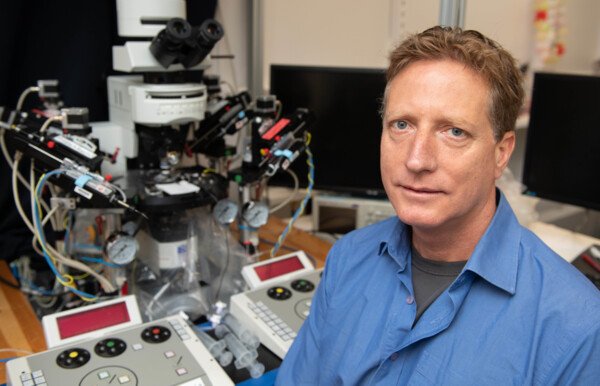Studying the brain’s neural code
Gilad Silberberg listens to individual nerve cells (neurons) in order to understand the fundamental principles of their complex communication. His research focuses above all on the basal ganglia and how they form the fundamental link between sensory perception and motor function.

What are you researching?
“The basic functions of our brain are a result of electrical activity between neurons. In my group, we are studying the communication within those neural networks – in the healthy brain and in various forms of illness. There is a complex interaction in which different kinds of neurons work together according to certain rules, a bit like the instruments in a symphony orchestra.”
“Above all, we are studying sensory perception and motor control in the basal ganglia. Which neurons talk to each other? What is the balance between excitatory and inhibitory neurons? What determines whether a neuron will be active or silent? We are trying to understand the principles of this interaction by listening individually to several neighbouring neurons simultaneously, and also stimulating them to see how they respond under different conditions.”
What have you discovered?
“Some of our findings relate to processes of sensory perception in basal ganglia. Among other things, we have shown that input from different senses, for example touch and sight, are integrated in striatum by the same neurons. Another discovery is that the integration of sensory information from a person’s left and right sides is impaired in Parkinson’s disease. It is important for the brain to be able to detect inputs from the right and the left, which is why the electrical signals are different, but in Parkinson’s this differentiation is reduced because of the lack of dopamine. Other important findings relate to how the neural circuits in basal ganglia are organised.”
Can the research result in clinical value?
“Our research is above all basic research driven by scientific curiosity, but the possibility of clinical applications does exist. Parkinson’s and Huntington’s diseases are two examples of illnesses with a strong link to the mechanisms we are studying. For example, more knowledge about how sensory perception is affected by Parkinson’s disease could provide new opportunities for diagnosis of Parkinson’s at earlier stages than at present.”
Text: Anders Nilsson, in translation from Swedish.
First published in the booklet From Cell to Society 2018.
About Gilad Silberberg
Professor of Neurophysiology at the Department of Neuroscience
Gilad Silberberg was born in Beersheba, Israel, in 1968. After studying physics and neurobiology, he earned his PhD in Neurobiology at the Weizmann Institute of Science, Rehovot, Israel. From 2003 to 2004 he was a postdoctoral researcher at the Laboratory of Neural Microcircuitry at the Brain Mind Institute in Lausanne, Switzerland. Silberberg came to Karolinska Institutet in 2005, working for the first three years as a postdoc in Sten Grillner’s lab at the Nobel Institute for Neurophysiology.
In 2008 Silberberg started his own lab at KI’s Department of Neuroscience and became an associate professor in 2011. He was awarded an ERC Starting Grant in 2011 and became a Wallenberg Academy Fellow in 2012. Gilad Silberberg was appointed Professor of Neurophysiology at Karolinska Institutet on 1 April 2018.
